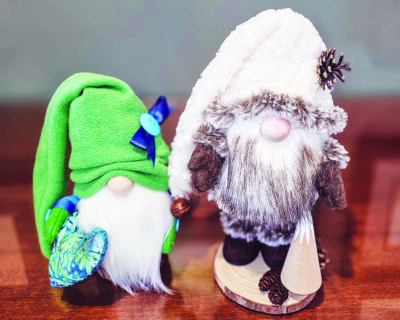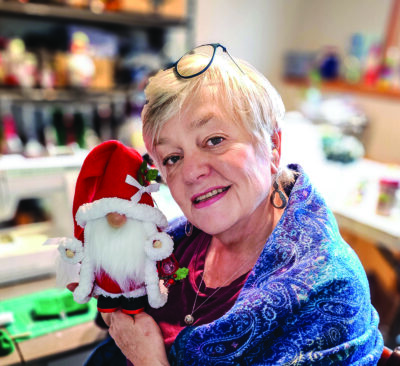Nancy Edmonds Hanson
- Each of Martha Wheeler’s gnomes has its own personality, as well as materials to suit its style, from fabric to pinecones and clay components.
- Martha Wheeler crafts hundreds of gnomes — each an original — in her home workroom. (Photos/Nancy Hanson.)
Gnomes – those diminutive pointy-hatted sprites enshrined in folk art – first made their mark on America out in the garden. Wearing red conical hats and sporting voluminous beards, the imaginary, iconic figures have graced many a carefully tended plot over the years.
Martha Wheeler of Moorhead has sprung them free. Ever since the pandemic curtailed the retired music teacher’s travels with husband David, she has been bringing a flock of the little pixies to life, each imbued with its own personality and style. Some linger among their traditional kin, favoring bees and flowers – two of Martha’s favorite motifs. She sells her crafty offspring at festivals and vendor shows, including last week’s final sale at the Center Mall and the year’s final booking at Dakota Vines Winery of Colfax, North Dakota, from 11 a.m. to 4 p.m. on Small Business Saturday, Nov. 25.
But others venture far from their original haunts. Operating under the moniker of Gnomistry (melding “gnome” and “artistry”), the hand-fashioned figures may sport the colors and gear of the Spuds, Bison, Twins or Vikings … carry tools of all kinds of trades, from real estate “sold” signs to podcast logos … walk tiny dogs … mimic the style of orange tabby cats … or provide a perch for birds or butterflies. And inevitably, her collection of the elvish gnomes includes Santa Claus himself.
“My gnomes have become kind of an obsession,” Martha admits. “As long as I have time for my activism and to be a grandma, they fill in the rest of my days.” Active with Moms Demand Action for Gun Safety, she often cares for grandsons Leander, now 8, and 5-year-old Macsen, who has pitched in to make his own gnomes.
Martha’s first gnomes were ornaments for her family’s Christmas tree, along with a gnomish tree topper. Their number quickly escaped from their usual niches, becoming a flock of free-standing characters. She added figures with stuffed fabric bodies and ever-stretching hats, then experimented with pine cone and bottle brush torsos.
Gnomes, she explains, never have eyes, though some, oddly enough, wear glasses. Their hats slip down to the bridges of their bulbous noses. Traditional gnomes skew male, but she added female gnomes as well, substituting fat, bow-tied braids for the usual emblematic beards. In a departure from the simple, truncated form of the originals, many of Martha’s gnomes have arms, the better to hold everything from pine cones to posies. Then came dangling legs and stubby feet – a departure from the truncated type: running shoes, boots, even bare tootsies with tiny toes fashioned from clay.
Each handmade character takes the better part of a day, she reports. Her basement workroom is piled with fabric and furry remnants, polyester fill and props that may someday come in handy.
It’s a new life for the thousand-year-old pixies. Born in Scandinavia a thousand years ago, the Norwegians called them nissen. the Swedes tomten. The friendly but reclusive spirits were said to inhabit dark places, often living deep in the forests. When the legends spread to Germany, they seemed to move into farmsteads and gardens, where they lingered until modern crafters fascination brought them to the fore.
“But I’m not as interested in their background as in their basic cuteness,” the gnomist emphasizes.
Martha’s passion for little people began, she says, with YouTube videos on making sock figures. She quickly branched out, developing her own patterns and experimenting with sometimes-unexpected materials. She has taught the art of gnomistry at the Crooked Lane Farm Folk Art School near Colfax.
Picking up a chubby Santa Claus gnome amidst a workroom stacked with boxes and shelves of petite personalities, she says, “People seem to love these little guys just as much as I do making them. And when I do something, I tend to go all in.”
For a closer look at Martha’s creations, search for her personal page and Gnomistry on Facebook.




